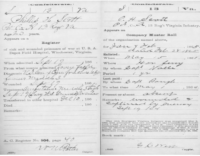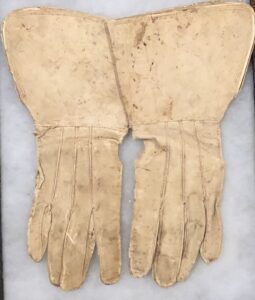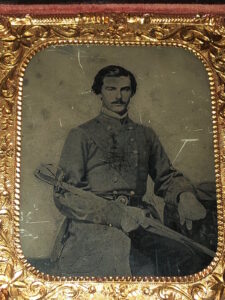Bible Picked Up off “The Battlefield” by Private Philip H. Scott Co. A 13th Va. Infantry on July 3, 1863
$1,650
Bible Picked Up off “The Battlefield” by Private Philip H. Scott Co. A 13th Va. Infantry on July 3, 1863 – This combination pocket size, Old and New Testament, published in 1860, bound in its original, black leather, wallet-like cover, was found on an unnamed battlefield, on July 3, 1863, by Confederate Infantryman Private Philip H. Scott of Co. A 13th Virginia Infantry. Inscribed, in ink, on the inner paper of the front board is the following:
“James G. Scott
Smithfield
Va
Found on the battlefield by
Philip H. Scott
Co. A. 13th Va Infantry
During the Confeder
Ate War for Inde
pendence “
On the next page (frontispiece) is inscribed, in ink, the following:
“Nellie B. Scott
for her brother
Phil
July 3, 1863
To James Gaillard Scott
from his Aunt Nelly
on his 8th birthday
Sept. 26, 1898”
Philip Henshaw Scott, a University of Virginia student, enlisted in Co. A of the 13th Va. Infantry in March, 1861. He was wounded at 2nd Manassas in August, 1862 and was later detailed as a clerk at Brigade Headquarters in December, 1862. He rejoined his original regiment in November, 1863, only to be severely wounded at the Battle of Winchester on September 19, 1864 and captured and sent, initially, to Fort McHenry in Maryland; subsequently, he was sent to Point Lookout, Md. where his leg was amputated, on Sept. 29, 1864. Scott was paroled in February, 1865 and sent to a Richmond hospital. Scott would live only a few years after the war, dying in 1871, at the age of 32.
The Bible remains in overall good condition, although the spine is broken, so the Bible “breaks” in half. There is no damage to the interior and the leather covering the boards and spine – both are in good condition. The 13th Va. was held in abeyance at Winchester as provost guard, so it is conceivable that the Bible was picked up by a comrade on July 3, 1863, after Pickett’s Charge, at Gettysburg, and given to Private Henshaw. The additional names, to include his brother, were all relatives or descendants of Henshaw.
Philip Henshaw Scott
Residence was not listed; years old.
Enlisted on 3/15/1861 at Harper’s Ferry, VA as a Priv.
On 3/15/1861, he mustered into “A” Co. Virginia 13th Infantry.
(Date and method of discharge not given.)
He was listed as:
- Absent, sick 3/15/1862 (place not stated)
- Returned 6/15/1862 (place not stated) (Estimated day)
- Wounded 8/29/1862 2nd Manassas, VA (In shoulder)
- Detailed 12/21/1862 (place not stated) (As clerk at brigade HQ)
- Returned 11/1/1863 (place not stated)
- POW 9/19/1864 Winchester, VA
- Wounded 9/19/1864 Winchester, VA (Severely wounded in right leg, amputated)
- Confined 9/21/1864 Gnl Hospl, West Bldgs
- Confined 9/25/1864 Fort McHenry, MD
- Confined 9/29/1864 Point Lookout, MD (Leg amputated)
- Paroled 2/15/1865 (place not stated) (Estimated day)
- Hospitalized 3/2/1865 Richmond, VA
- Furloughed 3/7/1865 (place not stated) (No further record)
Died 8/5/1871 in Gordonsville, VA
Buried: Windholme Farm Cem. 2, Orange County, VA
(Born 1839. Attended U VA)
13th VA Infantry
Organized: on 5/9/1861
Mustered out: 4/23/1862
| From | To | Brigade | Division | Corps | Army | Comments |
| Jul ’61 | Jul ’61 | 4th | Army of Potomac | |||
| Jul ’61 | Nov ’61 | 4th | 2nd | Army of Potomac | ||
| Nov ’61 | Jan ’62 | 4th | E.K. Smith’s | 1st | Army of Potomac | |
| Jan ’62 | Mar ’62 | 4th | E.K. Smith’s/Ewell’s | Potomac District | Dept of Northern Virginia | |
| Mar ’62 | May ’62 | 4th | Ewell’s | Dept of Northern Virginia | ||
| May ’62 | Jun ’62 | 4th | Ewell’s | Valley District | Dept of Northern Virginia | |
| Jun ’62 | Jun ’62 | Elzey’s | Ewell’s | 2nd | Army of Northern Virginia | |
| Jul ’62 | Mar ’63 | Early’s | Ewell’s | 2nd | Army of Northern Virginia | |
| Mar ’63 | Sep ’63 | Smith’s | Ewell’s/Early’s | 2nd | Army of Northern Virginia | |
| Oct ’63 | Jun ’64 | Pegram’s | Ewell’s/Early’s | 2nd | Army of Northern Virginia | |
| Jun ’64 | Dec ’64 | Pegram’s | Ramseur’s/Pegram’s | Valley District | Dept of Northern Virginia | |
| Dec ’64 | Apr ’65 | Pegram’s/Walker’s | Pegram’s | 2nd | Army of Northern Virginia |
13th Regiment, Virginia Infantry
Overview:
13th Infantry Regiment completed its organization during the summer of 1861 with men from Winchester and Culpeper, Orange, Louisa, and Hampshire counties. After fighting at First Manassas and in Jackson’s Valley Campaign, it served in General Early’s, W.Smith’s, Pegram’s, and J.A. Walker’s Brigade. The 13th was prominent in the campaigns of the Army of Northern Virginia from the Seven Days’ Battles to Cold Harbor, then it moved with Early to the Shenandoah Valley and later was involved in the Appomattox operations. It reported 16 casualties at Cross Keys and Port Republic, 111 at Gaines’ Mill, 34 at Cedar Mountain, 46 at Second Manassas, 22 at Fredericksburg, and 36 at Chancellorsville. During the Gettysburg Campaign it was left at Winchester as provost guard. The unit sustained heavy losses at Cedar Creek and surrendered with 10 officers and 52 men. Its commanders were Colonels George A. Goodman, Ambrose P. Hill, James B. Terrill, and James A. Walker; and Majors Charles T. Crittenden and John B. Sherrard.
13th Virginia Infantry Regiment
| 13th Virginia Infantry Regiment | |
| Flag of Virginia, 1861 | |
| Active | Summer 1861 – Spring 1865 |
| Disbanded | April 1865 |
| Country | Confederacy |
| Allegiance | Confederate States of America |
| Branch | Confederate States Army |
| Type | Infantry |
| Engagements | American Civil War |
| Commanders | |
| Notable commanders | Colonel A.P. Hill Colonel James A. Walker |
The 13th Virginia Infantry Regiment was an infantry regiment raised in central and western Virginia for service in the Confederate States Army during the American Civil War. It fought mostly with the Army of Northern Virginia.[1]
Its commanders were Colonels George A. Goodman, Ambrose P. Hill, James B. Terrill, and James A. Walker; and Majors Charles T. Crittenden and John B. Sherrard.
| Company | Nickname | Recruited at | Commanding Officers |
| A | Montpelier Guard | Orange County | Champ G. Cooke, George Cullen, Benjamin F. Naile Weisiger |
| B | Culpeper Minute Men | Culpeper County | Charles T. Crittenden, Williamson G. George, Waller T. Patton, Zephaniah T. Ross |
| C | Gordonsville Grays | Orange County | George A. Goodman, Charles H. Richards, William C. Scott |
| D | Louisa Blues | Louisa County | John W. Hibbs, Henry W. Murray, Frank V. Winston |
| E | Culpeper Riflemen Brandy Rifles | Culpeper County | Stockton Heth, William A. Ashby, John L. Brooks, Daniel Field |
| F | Barboursville Guards | Orange County | Andrew J. Eheart, Charles L. Graves, Conway Newman, William S. Parran |
| G | Lanier Guard | Maryland | Frank T. Hill, Alexander G. Taliaferro |
| H | Fort Loudoun Guards Winchester Boomerangs | Winchester Frederick County | Samuel D. Buck, William H. Harrison, Lewis N. Huck, William H. Sherer |
| I | Frontier Rifles Hampshire Guard | Hampshire County | Job N. Cookus, Abraham Smith, Robert White, Felix Heiskell, John B. Sherrard |
The 13th Virginia completed its organization during the summer of 1861 with men from Winchester and Culpeper, Orange, Louisa, and Hampshire counties, and one company from Maryland.[2] The original Companies B and E enlisted only for 6 months, the others for one year. At the end of that year, their service was extended for the duration of the war.
After fighting at First Manassas and in Jackson’s Valley Campaign, it served in General Early’s, W.Smith’s, Pegram’s, and J.A. Walker’s Brigade. The 13th was prominent in the campaigns of the Army of Northern Virginia from the Seven Days’ Battles to Cold Harbor, then it moved with Gen. Jubal Early to the Shenandoah Valley and later was involved in the Appomattox operations.
It reported 16 casualties at Cross Keys and Port Republic, 111 at Gaines Mill, 34 at Cedar Mountain, 46 at Second Manassas, 22 at Fredericksburg, and 36 at Chancellorsville. During the Gettysburg Campaign it was left at Winchester as provost guard. The unit sustained heavy losses at the Battle of Cedar Creek and surrendered at Appomattox Court House with 10 officers and 52 men.











































